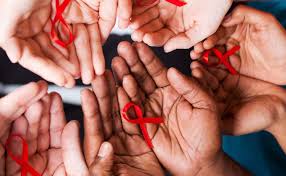How does HIV spread?

The person-to-person spread of HIV is called HIV transmission. HIV is transmitted (spread) only in certain body fluids from a person who has HIV:
- Blood
- Semen
- Pre-seminal fluids
- Rectal fluids
- Vaginal fluids
- Breast milk
HIV transmission is only possible if these fluids come in contact with a mucous membrane or damaged tissue or are directly injected into the bloodstream (from a needle or syringe). Mucous membranes are found inside the rectum, the vagina, the opening of the penis, and the mouth.
HIV can also spread from a woman with HIV to her child during pregnancy, childbirth (also called labor and delivery), or breastfeeding. This spread of HIV is called mother-to-child transmission of HIV. In the past, some people were infected with HIV after receiving a blood transfusion or organ or tissue transplant from a donor with HIV. Today, this risk is very low because donated blood, organs, and tissues are carefully tested in the United States.
You can’t get HIV from casual contact with a person who has HIV, for example from a handshake, a hug, or a closed-mouth kiss. And you can’t get HIV from contact with objects such as toilet seats, doorknobs, or dishes used by a person who has HIV. Use the HIVinfo You Can Safely Share…With Someone With HIV infographic to spread this message.
How can I reduce my risk of getting HIV
Anyone can get HIV, but you can take steps to protect yourself from HIV infection.
- Get tested and know your partner’s HIV status. Talk to your partner about HIV testing and get tested before you have sex. Use this testing locator from the Centers for Disease Control and Prevention (CDC) to find an HIV testing location near you.
- Have less risky sex. HIV is mainly spread by having anal or vaginal sex without a condom or without taking medicines to prevent or treat HIV.
- Use condoms. Use a condom correctly every time you have sex. Read this fact sheet from CDC on how to use condoms correctly.
- Limit your number of sexual partners. The more partners you have, the more likely you are to have a partner with HIV whose HIV is not well controlled or to have a partner with a sexually transmitted disease (STD). Both of these factors can increase the risk of HIV transmission. If you have more than one sexual partner, get tested for HIV regularly.
- Get tested and treated for STDs. Insist that your partners get tested and treated too. Having an STD can increase your risk of becoming infected with HIV or spreading it to others.
- Talk to your health care provider about pre-exposure prophylaxis (PrEP). PrEP is an HIV prevention option for people who don’t have HIV but who are at high risk of becoming infected with HIV. PrEP involves taking a specific HIV medicine every day. For more information, read the HIVinfo fact sheet on Pre-Exposure Prophylaxis (PrEP).
- Don’t inject drugs. But if you do, use only sterile drug injection equipment and water and never share your equipment with others.
How can I protect my partner from HIV
Take HIV medicines daily. Treatment with HIV medicines (called antiretroviral therapy or ART) helps people with HIV live longer, healthier lives. ART can’t cure HIV infection, but it can reduce the amount of HIV in the body (also called the viral load). Having less HIV in your body will reduce your risk of transmitting HIV to your partner.
However, even someone who is taking HIV medicines and has an undetectable viral load can still potentially transmit HIV to a partner. To further lower your risk of transmitting HIV to your partner, you can use condoms correctly every time you have sex and talk to your partner about taking PrEP. If you inject drugs, don’t share your needles, syringes, or other drug equipment with your partner.
Are HIV medicines used to prevent HIV infection
Post-exposure prophylaxis (PEP): PEP is the use of HIV medicines to reduce the risk of HIV infection soon after a possible exposure to HIV. PEP may be used, for example, after a person has sex without a condom with a person who has HIV or after a health care worker is accidentally exposed to HIV in the workplace. To be effective, PEP must be started within 3 days after the possible exposure to HIV. PEP involves taking HIV medicines each day for 28 days.
Prevention of mother-to-child transmission of HIV: Women with HIV take HIV medicines during pregnancy and childbirth to reduce the risk of passing HIV to their babies. Their newborn babies also receive HIV medicine for 4 to 6 weeks after birth. The HIV medicine reduces the risk of infection from any HIV that may have entered a baby’s body during childbirth.